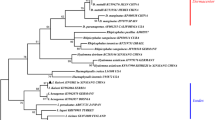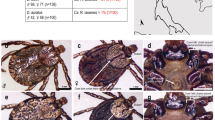Abstract
Argasid ticks are vectors of viral and bacterial agents of humans and animals. Carios capensis, a tick of seabirds, infests the nests of brown pelicans, Pelecanus occidentalis, and other ground nesting birds along the coast of South Carolina. This tick is associated with pelican nest abandonment and could pose a threat to humans visiting pelican rookeries if visitors are exposed to ticks harboring infectious agents. We collected ticks from a pelican rookery on Deveaux Bank, South Carolina and screened 64 individual ticks, six pools of larvae, and an egg mass for DNA from Bartonella, Borrelia, Coxiella, and Rickettsia by polymerase chain reaction amplification and sequencing. Ticks harbored DNA from “Borrelia lonestari”, a novel Coxiella sp., and three species of Rickettsia, including Rickettsia felis and two undescribed Rickettsia spp. DNA from the Coxiella and two undescribed Rickettsia were detected in unfed larvae that emerged in the laboratory, which implies these agents are transmitted vertically by female ticks. We partially characterize the novel Coxiella by molecular means.
Similar content being viewed by others
References
Barbour AG, Maupin GO, Teltow GJ, Carter CJ, Piesman J (1996) Identification of an uncultivable Borrelia species in the hard tick Amblyomma americanum: possible agent of a Lyme disease-like illness. J Infect Dis 173:403–409
Carl M, Tibbs CW, Dobson ME, Paparello S, Dasch GA (1990) Diagnosis of acute typhus infection using the polymerase chain reaction. J Infect Dis 161:791–793
Converse JD, Hoogstraal H, Moussa MI, Feare CJ, Kaiser MN (1975) Soldado virus (Hughes group) from Ornithodoros (Alectorobius) capensis (Ixodoidea: Argasidae) infesting sooty tern colonies in the Seychelles, Indian Ocean. Am J Trop Med Hyg 24:1010–1018
Doherty RL, Whitehead RH, Wetters EJ, Johnson HN (1969) Isolation of viruses from Ornithodoros capensis Neumann from a tern colony on the Great Barrier Reef, North Queensland. Aust J Sci 31:363–364
Duffy DC (1983) The ecology of tick parasitism on densely nesting Peruvian seabirds. Ecology 64:110–119
Durden LA, Wills W, Clark KL (1999) The fleas (Siphonaptera) of South Carolina with an assessment of their vectoral importance. J Vector Ecol 24:171–181
El Shoura SM (1990) Ultrastructure and distribution of intracellular rickettsia-like microorganisms in various organs of the laboratory-reared adult tick Argas (Persicargas) arboreus (Ixodoidea: Argaside). Exp App Acarol 9:137–143
Estrada-Pena A, Jongejan F (1999) Ticks feeding on humans: a review of records on human-biting Ixodoidea with special reference to pathogen transmission. Exp Appl Acarol 23:685–715
Ewing SA, Harkess JR, Kocan KM, Barker RW, Fox JC, Tyler RD, Cowell RL, Morton RB(1990) Failure to transmit Ehrlichia canis (Rickettsiales: Ehrlichieae) with Otobius megnini (Acari: Argasidae). J Med Entomol 27:803–806
Fournier PE, Roux V, Raoult D (1998) Phylogenetic analysis of spotted fever group rickettsiae by study of the outer surface protein rOmpA. Int J Syst Bacteriol 48:839–849
Guedes E, Leite RC, Prata MC, Pacheco RC, Walker DH, Labruna MB (2005) Detection of Rickettsia rickettsii in the tick Amblyomma cajennense in a new Brazilian spotted fever-endemic area in the state of Minas Gerais. Mem I Oswaldo Cruz 100:841–845
Hoogstraal H, Bafort JM (1982) Ticks of Saudi Arabia Ornithodoros (Alectorobius)muesebecki (Acarina: fam. Argasidae) parasitizing marine birds in the Arabian Gulf, Saudi Arabia. Fauna Saudi Arabia 4:23–28
Hoogstraal H (1985) Argasid and nuttalliellid ticks as parasites and vectors. Adv Parasit 24:135–238
Hoogstraal H, Wassef HY, Hays C, Keirans JE (1985) Ornithodoros (Alectorobius) spheniscus n. sp. (Acarina: Ixodoidea: Argasidae: Ornithodoros (Alectorobius) capensis group), a tick parasite of the Humboldt Penguin in Peru. J Parasitol 71:635–644
Houpikian P, Raoult D (2001) 16S/23S rRNA intergenic spacer regions for phylogenetic analysis, identification, and subtyping of Bartonella species. J Clin Microbiol 39:2768–2778
Keirans JE, Hutcheson HJ, Oliver JH Jr (1992) Ornithodoros (Alectorobius) capensis Neumann (Acari: Ixodoidea: Argasidae), a parasite of seabirds, established along the Southeastern seacoast of the United States. J Med Entomol 29:371–373
King KA, Blankinship DR, Paul RT (1977a) Ticks as a factor in the 1975 nesting failure of Texas brown pelicans. Wilson Bull 89:157–158
King KA, Keith JO, Mitchell CA, Keirans JE (1977b) Ticks as a factor in nest desertion in California brown pelicans. Condor 79:507–508
Lee JH, Park HS, Jang WJ, Koh SE, Park TK, Kang SS, Kim BJ, Kook YH, Park KH, Lee SH (2004) Identification of the Coxiella sp. detected from Haemaphysalis longicornis ticks in Korea. Microbiol Immunol 48:125–130
Mediannikov O, Ivanov L, Nishikawa M, Saito R, Sidelnikov YN, Zdanovskaya NI, Tarasevich IV, Suzuki H (2003) Molecular evidence of Coxiella-like microorganism harbored by Haemaphysalis conicinnae in the Russian Far East. Ann Acad Sci 990:226–228
Noda H, Munderloh UG, Kurtti TJ (1997) Endosymbionts of ticks and their relationship to Wolbachia spp and tick-borne pathogens of human and animals. Appl Environ Microbiol 63:3926–3932
Podboronov VM, Pchelkina AA (1989) Characteristics of the transphase and transovarial transmission of Rickettsia sibirica by ixodid and argasid ticks. (in Russian) Med Parazitol (Moscow) July–August:14–18
Reeves WK (2005) Molecular genetic evidence for a novel bacterial endosymbiont of Icosta americana (Diptera: Hippoboscidae). Entomol News 116:263–265
Reeves W, Durden L, Wills W (2002) New records of ticks (Acari: Argasidae, Ixodidae) from South Carolina. J Agr Urban Entomol 19:197–204
Roshdy MA (1968) A rickettsialike (sic) microorganism in the tick Ornithodoros savignyi; observations on its structure and distribution in the tissues of the tick. J Invertebr Pathol 11:155–169
Roux V, Rydkina E, Eremeeva M, Raoult D (1997) Citrate synthase gene comparison, a new tool for phylogenetic analysis, and its application for the rickettsiae. Int J Syst Bacteriol 47:252–261
Sekeyova Z, Roux V, Raoult D (1999) Intraspecies diversity of Coxiella burnetii as revealed by com1 and mucZ sequence comparison. FEMS Microbiol Letters 180:61–67
Skerman VBD, McGowan V, Sneath PHA (1980) Approved lists of bacterial names. Int J Syst Bacteriol 30:225–420
Stein A, Raoult D (1992) Detection of Coxiella burnetii by DNA amplification using polymerase chain reaction. J Clin Microbiol 30:2462–2466
Stein A, Kruszewska D, Gouvernet J, Raoult D (1997) Study of the 16S–23S ribosomal DNA internal spacer of Coxiella burnetii. Eur J Epidemiol 13:471–475
Stevenson HL, Labruna MB, Montenieri JA, Kosoy MY, Gage KL, Walker DH (2005) Detection of Rickettsia felis in a New World flea species, Anomiopsyllus nudata (Siphonaptera: Ctenophthalmidae). J Med Entomol 42:163–167
Varela AS, Luttrell MP, Howerth EW, Moore VA, Davidson WR, Stallknecht DE, Little SE (2004) First culture isolation of Borrelia lonestari, putative agent of southern tick-associated rash illness. J Clin Microbiol 42:1163–1169
Wedincamp J Jr, Foil LD (2002) Vertical transmission of Rickettsia felis in the cat flea (Ctenocephalides felis Bouché). J Vector Ecol 27:96–101
Whitlock JE, Fang QQ, Durden LA, Oliver JH Jr (2000) Prevalence of Ehrlichia chaffeensis (Rickettsiales: Rickettsiaceae) in Amblyomma americanum (Acari: Ixodidae) from the Georgia coast and barrier islands. J Med Entomol 37:276–280
Williams SG, Sacci JB Jr, Schriefer ME, Andersen EM, Fujioka KK, Sorvillo FJ, Barr AR, Azad AF (1992) Typhus and typhuslike (sic) rickettsiae associated with opossums and their fleas in Los Angeles County, California. J Clin Microbiol 30:1758–1762
Williams DC, Wills W, Durden LA, Gray EW (1999) Ticks of South Carolina (Acari: Ixodoidea). J Vector Ecol 24:224–232
Yuasa Y, Yoshiie K, Takasaki T, Yoshida H, Oda H (1996) Retrospective survey of chronic Q fever in Japan by using PCR to detect Coxiella burnetii DNA in paraffin-embedded clinical samples. J Clin Microbiol 34:824–827
Yunker CE, Clifford CM, Keirans JE, Thomas LA, Rice RCA (1979) Aranas Bay Virus, a new arbovirus of the Upolu serogroup from Ornithodoros capensis (Acari: Argasidae) in coastal Texas. J Med Entomol 16:453–460
Acknowledgments
We thank P.H. Adler, R.L. Hassell, T.M. Murphy, M.P. Nelder, W.C. Reeves, and B.M. Shepard, for assistance with field collections and loaning of equipment. The opinions and assertions contained herein are the private views of the authors and are not to be construed as official or reflecting the views of the United States Government. The findings and conclusions in this report are those of the authors and do not necessarily represent the views of the funding agency.
Author information
Authors and Affiliations
Corresponding author
Rights and permissions
About this article
Cite this article
Reeves, W.K., Loftis, A.D., Sanders, F. et al. Borrelia, Coxiella, and Rickettsia in Carios capensis (Acari: Argasidae) from a brown pelican (Pelecanus occidentalis) rookery in South Carolina, USA. Exp Appl Acarol 39, 321–329 (2006). https://doi.org/10.1007/s10493-006-9012-7
Received:
Accepted:
Published:
Issue Date:
DOI: https://doi.org/10.1007/s10493-006-9012-7




